Neurotechnology company Neuralink, co-founded by Elon Musk in 2016, has installed the first brain implant in a human after getting the green light last May. “The patient is recovering,” the X founder wrote on social media.
Let’s find out what the first human brain implant is and how it works and why it is so important for Neuralink.
Table of Contents
Neuralink, the first brain implant installed on a man
The first human being received an implant from Neuralink on Sunday 28 January and is recovering well.
These are the words of Elon Musk in a post on X, in which he announced the installation of the first Neuralink brain implant on a human being.
Initial results show promising neuronal spike detection. The goal, we remember, is to be able to build direct communication channels between the brain and computers.
In a broader scope, however, the purpose of these implants could help us enhance human capabilities, treat neurological disorders such as ALS or Parkinson’s and perhaps even create a symbiotic relationship between humans and artificial intelligence.
How the first human brain implant works
The company co-founded by Musk confirmed that it had received the green light from US regulators to install the first brain implant on a human being, without however specifying how many men or women volunteers were involved in the experimentation, which it will last six years.
Brain-computer interfaces have the potential to change lives for the better – we read on the Neuralink website -. We want to bring this technology from the laboratory into people’s homes.
Essentially, a series of sensors (called “Stentrodes”) are inserted inside the blood vessels until they reach the upper part of the brain. These sensors are controlled remotely through a wireless receiver placed under the skin at chest level.
Thanks to this receiver, brain impulses are digitized and transmitted to PCs, tablets and smartphones, which can then be activated simply by thinking of a motor command.
But how does the system work? In summary, the so-called “Link” (a device the size of five coins stacked on themselves) is implanted in the human brain through an invasive surgery, hoping to be able to build a communication channel between the brain and computers.
Neuralink’s goals
One of Musk’s main goals is to create a symbiosis between humans and artificial intelligence, which is currently seen as a threat to humans only if left unchecked.
Musk’s aim is to be able to interpret the brain signals of disabled people to allow him to control their limbs. But Neuralink has much broader applications, which need to be tested over time.
The other experiences before Neuralink
Another device used for installing brain implants is the Synchron, whose company is based in Australia. Unlike Link, this device does not require installation by cutting the skull.
The first official installation of Synchron had taken place in the United States in July 2022, while Musk tried to contact the company to foresee future combined investments.
Read also: All of Musk’s somersaults on artificial intelligence












